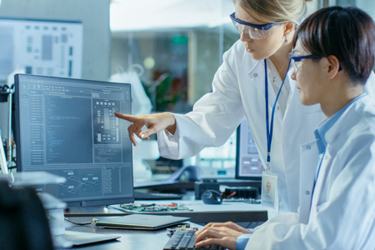2024 LIMS Trends
By Mike Lanewala and Tina Yauger, Clarkston Consulting

The laboratory information management system (LIMS) landscape in 2024 is a dynamic one, driven by accelerating advancements in technology and evolving industry needs. This year's trends report delves into the key drivers propelling market growth and how LIMS solutions are adapting to meet the demands of an increasingly competitive and data-driven scientific environment.
As we look ahead to 2024, the four trends we expect to see for LIMS include increased integration with instruments and other software systems; navigating market share challenges; a need for digital transformation, including the growing adaption of advanced analytics, artificial intelligence, (AI) and machine learning (ML) capabilities; and leveraging laboratory execution system (LES) and electronic laboratory notebook (ELN).
1. Increased LIMS Integration
LIMS integrations have historically included varying degrees of inventory or testing data transferred between the organization’s ERP (Enterprise Resource Planning) and their LIMS, or a basic integration of results passed from instruments to LIMS. The Lab of the Future has far more demanding integration and automation needs, which increases laboratory throughput and efficiency, reduces technician errors, enables large-scale analytics and AI, and drives down costs. While there’s a tremendous amount of benefit to be gained with this level of integration, there are still technical hurdles that must be overcome to achieve them.
In the past, instrument integration was typically set up in an instrument-by-instrument manner, which is time-consuming from a development and validation standpoint. Today, there’s an increasing number of vendors providing middleware solutions that tout pre-configured, modular integration solutions. For example, do you need to integrate a particular brand of HPLC? The vendor has likely already configured a template for the integration of that instrument. There will be efforts required to ensure that the appropriate test method data is transferred to the corresponding results in LIMS, but the amount of effort has been reduced. Additionally, once that method is defined, it is easily applied to other instruments of the same class. As additional instruments are onboarded, a profile can be assigned through the middleware where instruments can be integrated and validated more efficiently.
As companies push their manufacturing and laboratory operations into a more automated landscape, the ability of LIMS to integrate into a unified platform becomes critical. For example, advanced robotic sample storage solutions can allow technicians to select samples and have them delivered much like a vending machine. An integrated LIMS could send the required sample data to the freezer, which automatically picks the correct samples. Additional automation could move the samples through the facility to a designated sample area for technicians to retrieve. Other types of automation, such as robotics that perform method execution, also can integrate into the LIMS, sending the appropriate sample and test method data to the robot for execution. Following execution, the result data can be integrated back to LIMS. While this is a nascent area, the possibilities for laboratory throughput and efficiency are tremendous.
2. Navigating Market Share Challenges
The LIMS market was estimated at $2.3 billion in 2023 with an estimated Compound Annual Growth Rate of 6.8-7.8% through the end of the decade. As more companies in many industries continue to push for digital laboratories and enhanced automation, the demand for LIMS, the core of laboratory technology, will continue to grow.
Older, more established applications with a strong history of on-premise implementation will continue to face challenges from web- and cloud-hosted applications. Many other application suites outside of the laboratory have transitioned from on-premise to the cloud, and LIMS is no exception. Additionally, the desire to reduce dependence on internal teams to manage the LIMS and the associated master data is leading to a rise in SaaS (Software-as-a-Service) LIMS, with multiple vendors starting to provide SaaS options. As with many other types of software, there will be a growing contingent of companies that wish to outsource management and hosting of LIMS, versus those that wish to keep the application on-premise to increase control over the application and reduce dependency on external providers.
New players continue to move into the LIMS market or into different segments of the LIMS market. For example, Veeva is piloting a new LIMS product that does not have large market penetration yet; however, their presence and relationships in the eQMS space could significantly improve their chances of success. More established products (LabWare, LabVantage, Thermo Fisher Sample Manager, and StarLIMS) control approximately 80% of the LIMS market.
3. A Need For Digital Transformation
The 2020 pandemic changed the landscape of computing and resulted in a fast forward to a digital world – leading to a need for digital transformations in the laboratory. Incorporating computer-based systems into processes and strategies in the laboratory allows organizations to efficiently operate while minimizing costs. When considering laboratory operations, an organization’s LIMS and laboratory processes can help determine where to automate, become paperless, and streamline workflows. New versions of commercial LIMS solutions are expanding to incorporate ChatGPT-like searchability, including image and sound searching.
Advanced analytics, artificial intelligence (AI), and machine learning (ML) are the newest technology happening in the LIMS space. Key vendor platforms are integrating advanced analytics modules for the increasing amount of data being captured in the laboratory and manufacturing areas. The modules incorporate predictive AI and ML to assess the data and deliver warnings when the output is trending toward out-of-specification (OOS) results. The benefits of this are exponential in having less product reaching OOS, reducing waste and errors, and improving quality throughput.
Along with the use of the cloud is an increased use of tablets and mobile devices in the lab. LIMS platforms can operate on mobile devices, reducing valuable laboratory real estate and increasing the ability to work from anywhere. The mobile device can scan samples, accept result entry, and complete review of the samples (among many other LIMS tasks), all from the palm of a hand.
4. Leveraging Laboratory Execution System (LES) And Electronic Lab Notebook (ELN)
There are many similarities between a Laboratory Execution System (LES) and an Electronic Laboratory Notebook (ELN). They both offer a way to digitally capture all data of an experiment or test method including defining reagents, instruments, and other important metadata when performing the test. The LES is a structured format without flexibility, often used for test methods with an SOP (Standard Operating Procedure) to be followed with each iteration of the test. The ELN is a more flexible solution that provides the behavior of a laboratory notebook with flexibility to add elements and controls during testing or experiments.
In the data-driven world of the laboratory, the need to capture these elements digitally has grown. Eliminating paper notebooks has allowed organizations to reduce space needed for retention, increase sustainability, and, most importantly, easily extract data at any time. Many LIMS platforms have an option to add the ELN and/or LES module for a seamless way to capture data, inventory, sample information, and results all in one system.
Looking Ahead
The Lab of the Future is quickly becoming the Lab of Today. Vendors, both new and established, are competing to keep up with not only market share margins, but also with ever-changing technology. The future of LIMS includes more data, more efficiency, and reduced errors – all of which can be achieved with LES/ELN and instrument integration, automation, and AI and ML Advanced Analytics.
This article was previously published on Clarkston Consulting’s website. Republished with permission.
 About The Authors:
About The Authors:
Michael Lanewala is a manager at Clarkston Consulting with 20 years of experience working within life sciences. He has worked primarily with clients in the pharmaceutical and biotech industries, specializing in project management and the development of technical solutions. He has extensive experience implementing quality systems, especially laboratory information management systems (LIMS).
 Tina Yauger is a principal consultant at Clarkston Consulting. She has more than 13 years of experience working in the life sciences industries, where her clients are primarily in the pharmaceutical, biotech, and research and development areas. Yauger specializes in laboratory information management systems (LIMS) implementations and laboratory informatics. She has obtained numerous certifications in many areas of LIMS.
Tina Yauger is a principal consultant at Clarkston Consulting. She has more than 13 years of experience working in the life sciences industries, where her clients are primarily in the pharmaceutical, biotech, and research and development areas. Yauger specializes in laboratory information management systems (LIMS) implementations and laboratory informatics. She has obtained numerous certifications in many areas of LIMS.
